ISSN ONLINE(2319-8753)PRINT(2347-6710)
ISSN ONLINE(2319-8753)PRINT(2347-6710)
Naseema Khatoon1, Altaf Husain Khan2, Vinay Pathak3, Neeraj Agnihotri4, Masihur Rehman1
|
| Related article at Pubmed, Scholar Google |
Visit for more related articles at International Journal of Innovative Research in Science, Engineering and Technology
Hexavalent chromium is toxic, carcinogenic, probably mutagenic and highly soluble. The harmful effects of chromium include lung and throat cancer. Since chromium is an important heavy metal used in various industrial processes, it finds its way into the industrial effluents causing lethal environmental hazards. The impacts of chromium on human health and the environment is matter of concern. Remediation of Cr (VI) contaminated water poses both technological and economic challenges, as conventional methods are often too expensive and difficult to operate. Therefore, it is imperative that Cr (VI) be removed from contaminated water by using new material. NZVI particles are considered to be one of the important reducing agent to Cr (VI), transforming the same into non toxic Cr(III).The NZVI particles were prepared by chemical reduction method using Ferric chloride hexa hydrate (FeCl3.6H2O) with sodium borohydride (NaBH4).Removal of hexavalent chromium using NZVI particles as a Cr (VI) reducing agent was studied in synthetic waste water, containing 20 mg/L of hexavalent chromium. Chromium recovery batch study indicated that better recovery is achieved at lower pH and it increased with lowering of the pH of the aqueous solution. The optimum removal of the Cr (VI) and metal ions occurred at low pH (pH=3) and at maximum temperature of 250C.Chromium recovery of 99.9% was achieved within 2 min. at pH=3. After treatment, the Cr (VI) concentration was determined by UV–vis spectrophotometer by 1, 5-diphenyl carbazide method. This study demonstrates that NZVI particles have the potential to become an effective agent for the removal of Cr (VI) from synthetic model wastewater. Cleaning up of synthetic waste water has been successfully done by rapid removal of chromium Cr (VI) by NZVI particles from aqueous solution. Langmuir and Freundlich adsorption isotherm were used to explain the phenomena of adsorption.
Keywords |
| Adsorption, Heavy metals, Langmuir, Freundlich, NZVI |
I. INTRODUCTION |
| One of the most important and toxic heavy metals in wastewater is chromium. Cr (VI) is released from different industrial operations, including metallurgy, leather tanning, paint, textile industries, chemical manufacturing, pulp production, ore and petroleum refining, metal corrosion, electroplating and the manufacture of products for corrosion protection[1-2]. Chromium (VI) has been released to the environment via leakage, poor storage or improper disposal practices [3]. Over the decades, extensive use of chromium in tanning industries have resulted in chromium contaminated soil and ground water at production sites which pose a serious threat to human health, fish and other aquatic biodiversity[4].Cr(VI) causes skin, lung and throat cancers, infertility, increased incidences of birth and developmental defects among children living around tanneries, leather and chrome industries[5].The Ministry of Environment and Forest has set the permissible limit of Cr(VI) in industrial effluents to 0.05mg/L[6]. According to the World Health Organization (WHO) drinking water guidelines, the maximum recommended limit for total chromium is 0.05 mg/L, whereas, according to BIS (Bureau of Indian Standards) the maximum acceptable limit for Cr (VI) in drinking water is 0.05 mg/L. The recommended limit of Cr (VI) in waste water is only 0.05 mg/L. |
| Chromium (Cr), which is one of the most toxic and important heavy metals usually found in wastewater due to industrial activities of tanning and electroplating industries[7].In nature, chromium occurs either as Cr(VI) or as Cr(III)[8-9].In aqueous solution it most commonly is formed as Cr (VI) or Cr (III) [10-11].These two oxidation states are drastically different in charge, physicochemical properties as well as chemical and biochemical reactivity [12]. Cr (VI) is a highly toxic agent and carcinogenic. Cr (VI) is also known to be carcinogenic and mutagenic to living organisms [13-14].It can cause dermatitis, rhinitis, and even lung cancer or naso pharynx cancer. Because of its significant mobility in the subsurface environment, the potential risk of surface water contamination is high. It should be removed from contaminated waters. Cr (III), on the other hand, is less toxic, immobile, and readily precipitates as Cr (OH) 3 [15-17].Cr (III) is also considered to be a trace element essential for the proper functioning of living organisms [18].Cr (III) is considered as an essential element playing a role in carbohydrate and lipid metabolism [19]. |
| The conventional methods for the removing of Cr (VI) from wastewater have been developed such as adsorption, ion exchange, reverse osmosis chemical precipitation, electro-deposition, photo catalysis reduction, and solvent extraction [20].Cr (VI) containing wastewater from these processes is typically disposed by means of domestic sewage systems or even directly discharged to the aqueous bodies with little treatment in some undeveloped areas. During the last two decades, there has been important interest in using Nano Zero-Valent Iron (NZVI) particles as a Cr (VI) reducing agent. According to researcher amongst various technologies which are available to remove heavy metals from water, use of NZVI particles is reported as an ideal technique for in-situ remediation due to its large active surface area and high heavy metal adsorption capacity [21]. Under oxidising condition where chromium is present as Cr (VI) has the highest mobility where as chromium early precipitation as Cr (III) oxides with limited solubility makes chromium relatively immobile [22].In recent years, the use of Nano Zero-Valent Iron (NZVI) particles has been gaining increasing interest in the area of environmental remediation [23].Because of its larger specific surface area, higher surface reactivity [24], and unique catalytic activity [25]. Various studies have been reported on the use of NZVI particles for removing Cr (VI) in aqueous solutions [24, 26-28]. The mechanism of Cr (VI) removal from aqueous solutions by NZVI particles consists of the reduction, complexation, adsorption, precipitation or co precipitation [27]. |
| The objective of the present study was to investigate the role and the effectiveness of laboratory-synthesized NZVI particles in the removal of Cr (VI) from synthetic model wastewater. NZVI particles were synthesized by borohydride reduction method. The removal of Cr(VI) was studied under different experimental conditions i.e. amount of Cr(VI) and NZVI concentrations, variations in the levels of pH of solution and adsorption time. Equilibrium studies were conducted and isotherm parameters were obtained by application of Langmuir and Freundlich models. |
II. MATERIALS AND METHODS |
| A. Materials |
| All chemical reagents Ferric chloride, Sodium borohydride, and Ethanol, Potassium dichromate was used as a model synthetic contaminant. Nano pure water was used throughout the experiment. The chemicals used in this study were mostly of higher reagent grades. |
| B. Methods |
| 1) Preparation of Nano Zero-Valent Iron particles: Nano Zero Valent Iron particles are synthesized by mixing NaBH4 (0.25 M) and FeCl3·6H2O (0.045 M) solutions (1: 1 volume ratio) [13] The reaction is as follows |
| NZVI particles were synthesized by sodium borohydride reduction of ferric chloride. The fresh particles were prepared each day by dissolving 0.25 M NaBH4 aqueous solution drop wise in a 0.45 M FeCl3.6H2O aqueous solution at ambient temperature and under atmospheric conditions. These are the following steps to be carried for the preparation of solutions: Firstly we had to dissolve sodium borohydride (NaBH4, 4.7290 g) solids in 500ml of 0.1 M NaOH solution 0.25 M NaBH4 solution was obtained, and after that 6.0759 g of FeCl3.6H2O was dissolved into 500 ml Nano pure water (0.45 M FeCl3.6H2O). Instead of using water with NaBH4 we used NaOH solution because of the unstability of |
| NaBH4 in water which resulted in loss of reduction of power. Excessive borohydride was applied to accelerate the synthesis. Addition of the NaBH4 to the FeCl3 solution in the presence of vigorous magnetic stirring resulted in the rapid formation of fine black precipitated as the ferric iron reduced to NZVI and precipitated. The synthesized iron particles were then washed several times with deionized (DI) water and ethanol before use or stored in water containing 5% ethanol [29]. |
| 2) Preparation of Stock solution Cr (VI): Stock solution (1000 mg/L) of Cr (VI) was prepared by dissolving 2.829 g of K2Cr2O7 in 1000 ml of nanopure water |
| C. Characterization of Synthesized Nano Zero-Valent Iron particles |
| 1) X-Ray Diffraction: The X- ray diffraction studies of Zero-Valent Iron Nano Particles was performed with X-Pert PROPAN analytical instrument equipped with a graphite-mono chromatized operated at 40 kV and a current of 35 mA with Cu α radiation (λ=0.154060 nm ). A scan mode was used to collect 2θ data from 20o to 90o. A broad peak in XRD reveals existence of amorphous phase of iron. The crystalline size of the NZVI particle was calculated from the line broadening of X-ray diffraction peak according to the Debye-Scherer formula [30]. |
| D = k λ/ β Cos θ |
| Where D is the particle size in A °, k constant, λ wavelength of ↓-rays, and β the full width at half maxima of reflection at Braggs angle 2θ, θ Braggs angle. |
| 2) Scanning Electron Microscopy: The size distribution of the particles and Surface morphology was investigated with the Scanning Electron machine (SEM- LEO 430) operated at 25kV, magnification kx 56.99. The solid samples were sprinkled on the adhesive carbon tape which is supported on a metallic disk. |
| D. Cr (VI) Removal Batch Studies |
| In this work, batch experiments were conducted using NZVI particles in synthetic model wastewater (K2Cr2O7 solution) to examine the effects of different reaction parameters. Experimental solutions of the desired concentrations 10mg/l, 15 mg/l, 20mg/l, 25m g/l and 30mg/l of chromium were obtained by successive dilutions and Cr (VI) was determined via 1, 5-diphenylcarbazide (DPC) colorimetric method by measuring the absorbance at a wavelength of 540 nm using UV/VIS spectrophotometer (Elico-SL160). 0.1 M NaOH or HCl was used to adjustment of pH and controlled by pH meter (Labtronic model LT-11). All adsorption e experiments were conducted at room temperature (25±2 âÃâæC) unless noted, and all of the adsorption results were corrected by blank tests in which no adsorbent was added into the Cr (VI) solution. In each experiment, 100ml of Cr(VI) solution of known concentration at pH=7was added to 0.25 g of NZVI particles in conical flasks in triplicate for each Cr(VI) solution for the determination of optimum experimental conditions. The experiments were done by different concentration of NZVI particles (0.1, 0.25, 0.5, 0.75, 1.0 g/100CC), initial Cr (VI) concentration (10, 15, 20, 25, 30 mg/L) and initial pH (3, 5, 7, 9, 11) in interval different time (0, 2,5,10, 15, 20, 25, 30 min). In this study, NZVI particles slurry was successfully used for chromium removal and recovery. Batch studies conducted using different concentrations of chromium removed 99.45 % chromium in 2 minutes. |
| E. Reduction of Cr (VI) by Nano Zero-Valant Iron |
| The Cr (VI) removal percentage (R) is calculated spectrophotometrically using the formula given eqn (2): |
 |
| Where V (L) represents the volume of chromium solution, m (mg) stands for the mass of the used NZVI particles [31]. |
| 1) Adsorption Isotherms: Both Freundlich and Langmuir adsorption isotherm were used to describe the equilibrium between adsorbate and the adsorbent in the present study which can be expressed respectively as eqn (4) and (5): |
 |
| Where, qe, is mass of adsorbate adsorbed over adsorbent (mg/g); Kf, is Freundlich capacity factor (units determined by qe); Ce, is equilibrium concentration of adsorbate in liquid phase after adsorption (mg/L); n, is Freundlich intensity parameter; qmax, is maximum amount of adsorbate that can be adsorbed (mg/kg); b, is Langmuir isotherm constant[32].Further, from empirical constant b, separation factor R (dimensionless) also called as R factor or equilibrium parameter was also determined using the equation: |
 |
| The value of R gives insight into the suitability of adsorbent for the adsorption i.e., affinity between adsorbate and adsorbent [33].If, R < 1.0 it represents favourable adsorption; R > 1.0 it represents unfavourable adsorption; and R = 0 irreversible adsorption. |
III RESULTS AND DISCUSSION |
| A. Characterization of NZVI particles |
| 1) X-Ray Diffraction Structure Of NZVI Nano Zero-Valent Iron: It is observed from the XRD pattern of NZVI Nano Zero-Valent Iron ( Fig. 1) that the prepared NZVI were in zero valent state as confirmed by a broad diffraction peak at 2θ = 44.8°. |
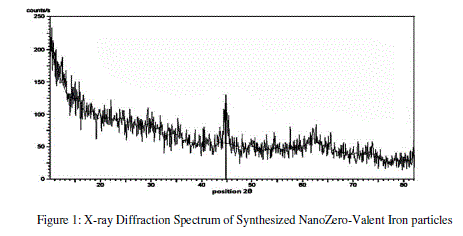 |
| B. Scanning Electron Microscopy |
| The characterization of the pristine samples collected from different crops synthesis of NZVI was conducted by Scanning Electron Microscopy. The result of present study was similar to those reported in the literatures [34]. Surface morphology of NZVI were carried out by SEM analysis and it was shown in Fig2.NZVIparticles were uniform in size and spherical in shape and the average size of NZVI particles is between30-40 nm. The aggregation is attributed to the magnetic forces among the iron particles. Similar phenomenon was observed by other researchers [35]. |
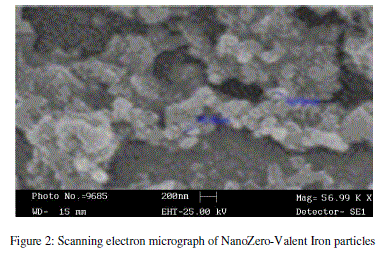 |
| C. Cr (VI) Reduction Studies |
| At the end of reduction/adsorption, the suspension was separated by using magnet. The chromium concentrations, prior to and after adsorption, were determined by UV–vis spectrophotometer. All the experiments are repeated three times and the average values of the results have been presented with minimum expected error of ± 5%. |
| D. Effect of pH on Cr (VI) Removal |
| The adsorption of chromium from aqueous solution using NZVI particles in this research was found to be a highly pH dependent process. pH of solution in fact determines the chemistry and speciation of chromium ions and also affects the surface charge of the adsorbent. In this experiment, the adsorption behaviour of Cr (VI) ions was studied at different pH values, using 0.25g/100cc of NZVI particles and a fixed concentration of chromium (20 mg/L). The results obtained are shown in Fig.3, which shows that removal of Cr (VI) ions increases with decreasing pH. When the initial pH values were 3, 5, 7and 11, the Cr(VI) reduction rates were 98.32%, 89.00%, 95.56%, 86.99% 73.68% and 58.44% respectively, after2 min of reaction. |
| It is observed that the maximum removal of Cr occurred at about pH=3.The Cr (VI) removal rate depends significantly on the pH of the solution, because the solubility of precipitate is strongly reliant on pH [36]. Cr (VI) removal was insignificant except when the solution pH was low enough to dissolve the passive oxide layers [37]. It is indicated that the NZVI particles have a high reactivity at pH=3. In contrast, the plots for pH greater than3 show less rapid removal efficiency is decreasing. This may be because of the formation of mixed Fe and Cr oxy hydroxides at high pH values on the iron surfaces [21, 38]. Solution of pH has an important effect on the reduction of Cr (VI) by NZVI particles. The pH value of solution changed slightly during the reaction process. It is evident that the reduction rate of Cr (VI) was greatly reduced under alkaline conditions because at a low pH (pH=3), the dominant form of Cr (VI) is HCrO4 − and the surface of the adsorbent is positively charged. By increasing of pH, theHCrO4 – species shifts to other forms CrO4 2− and Cr2O7 2– [39].The decrease in adsorption of Cr (VI) by increasing the pH is due to the competition between the anions CrO4 2− and OH− [24].Similar observations have been reported in other study[35]. |
 |
| E. Effect of Initial Concentration |
| Effect of initial concentrations of Cr(VI) on the removal efficiency of NZVI particles had been studied for five different concentrations of 10, 15, 20, 25 and 30 mg/L through batch experiment mode at pH=7, agitation rate of 3000 rotation per min, contact time of 2 to 30 minutes on NZVI particles at dose of 0.25 mg/100cc at constant temperature 25±20C and shown in Fig. 4.The removal efficiency was found to be 99.81%, 98.44%,95.77%, 88.15% and 62.80% respectively for different concentrations of chromium. The percentage adsorption increased rapidly up to the certain time duration and thereafter the increase becomes more and more insignificant. The decrease in the percentage removal of Cr (VI) can be explained with the fact that the NZVI particles had limited active sites, which would have become saturated above a certain circumstances [40]. |
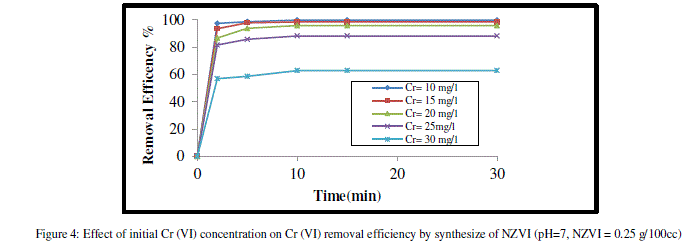 |
| F. Effect of NZVI Concentration on Cr (VI) Reduction |
| The effect of NZVI particle concentration on the adsorption of Cr (VI) ions in aqueous solution was studied by varying the NZVI particle concentration from 0.1 g/100ccto 1.0 g/100cc is given in Figure 5. It is evident that initially adsorption increases with increase in adsorbent dose, this is because as the adsorbent dose increases the number of sites available for adsorption increases. The percentage removal of Cr(VI) increased from 48.6% to 99.45% with the increase of the adsorbent concentration from 0.1 to 1 g/100cc. Increase in NZVI particle concentration increases the level of adsorption of Cr(VI) ions because of an overall increase in surface of the NZVI particle which in turn increase the number of binding sites lead to the increase of Cr(VI) removal efficiency[41].Therefore more NZVI particles provide more iron surface-active sites for collision with Cr(VI) molecules to accelerate the Cr(VI)removal efficiency[35].Similar observations have been reported[42-43]. |
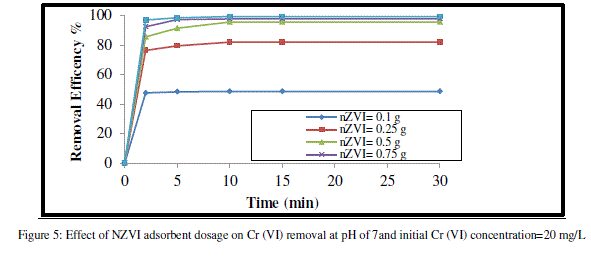 |
| G. Effect of contact time on Cr (VI) removal |
| The effect of time on the removal efficiency of the Cr (VI) were also studied at fixed adsorbent dose (0.1/100cc), pH (7), and 150 rpm agitation rate for different time intervals and the results are shown graphically in Figure 6. It had been established that optimum time required to attain the equilibrium between the Cr (VI) adsorbed on NZVI particles was within10 min. At this time the adsorption efficiency of 20mg/L Cr (VI) concentration was observed to be 41.34%, to47.82% respectively. |
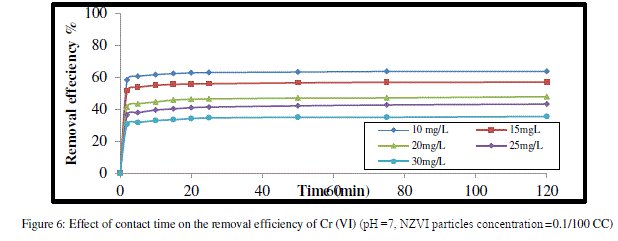 |
| H. Freundlich and Langmuir Adsorption Isotherms: |
| The equilibrium data was fitted to both Langmuir and Freundlich models. Plotting the experimental data using equations 3 and 4 in Fig.7 and Fig 8 indicates that both Freundlich and Langmuir models give good fit for the data. The isotherms constants were calculated and presented in Table 1. |
 |
| The Freundlich isotherm was fitted to the experimental data and the resulting isotherm parameters, were n=2.75 and k=9.38 for Cr (VI). As the value of n is a measure of the energy of adsorption and k is that of the adsorption capacity, it can be inferred that Cr (VI) has greater affinity and is more favorable for adsorption on NZVI particles. |
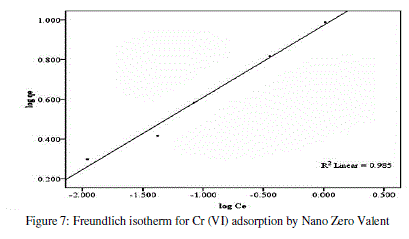 |
| The binding constant (qm) and the adsorbent capacity (Kq) are estimated by plotting Ce/qe against Ce (Figure 8). The Langmuir isotherm describes the experimental data better than Freundlich isotherm the experimental values of qm and Kq along with the linear regression co-efficient (r2) are given in Figure 8. |
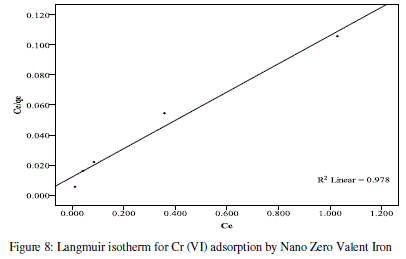 |
| The comparison of correlation coefficients (r2) indicates that both the adsorption isotherm models match satisfactorily with the experimental data obtained from the present study. The Langmuir isotherm describes the experimental data better than Freundlich isotherm. The value of R (dimensionless parameter) calculated from eq.6 was found to be 0.006 (R< 1), also shows the favourable adsorption of Cr on nZVI. |
IV. CONCLUSION |
| In this study, Chemical reduction method has been used for successful preparation of NZVI particles. Potassium dichromate as a model synthetic contaminant in water is used for evaluation of removal efficiency by NZVI particles. Thus the experimental condition result support the conclusion that reduction rate of Cr (VI) is significantly affected by Concentration of NZVI particles. It was found that the percentage adsorption of Cr (VI) decreased with the increase in the initial Cr (VI) concentration. This was expected due to the fact that for a fixed adsorbent dosage, the total available adsorption sites were limited thus leading to a decrease in percentage removal of the adsorb ate corresponding to an increase initial adsorbate concentration. Cr (VI) reduction efficiency is strongly affected by pH of reaction mixture with increasing initial pH & decreasing in initial Cr (VI) concentration. The equilibrium data was fitted to both Langmuir and Freundlich adsorption isotherm models. Thus from the use of NZVI particles reductive efficacy of Cr(VI) contaminated water can be done which is evidenced by the results obtained from current research. This has resulted in development of innovative remediation technology which is less costly & environment friendly. |
V. ACKNOWLEDGMENT |
| We are thankful to Birbal Sahni Institute of Palaeobotany, Lucknow for providing us the Scanning Electron Micrograph (SEM) image of NZVI particle sample. |
References |
|